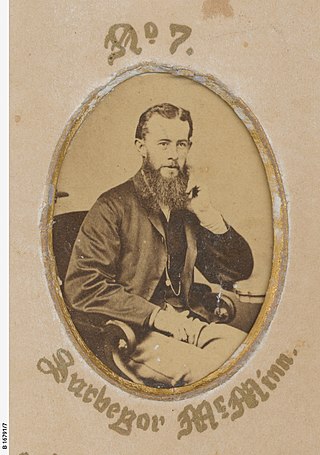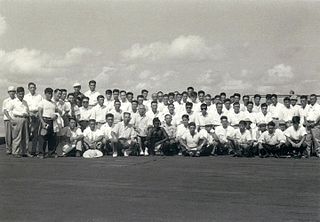Related Research Articles

Darwin is the capital city of the Northern Territory, Australia. With an estimated population of 147,255 as of 2019, the city contains the majority of the residents of the sparsely populated Northern Territory.

The former Central Australia Railway, which was built between 1878 and 1929 and closed in 1980, was a 1,241 km (771 mi) 1067 mm narrow gauge railway between Port Augusta and Alice Springs. A standard gauge line duplicated the southern section from Port Augusta to Maree in 1957 on a new nearby alignment. The entire Central Australia Railway was superseded in 1980 after the standard gauge Tarcoola–Alice Springs Railway was opened, using a new route up to 200 km to the west. A small southern section of the original line between Port Augusta and Quorn has been preserved as the Pichi Richi Tourist Railway.

George Woodroffe Goyder was a surveyor in the Colony of South Australia during the latter half of the nineteenth century.
The history of Darwin details the city's growth from a fledgling settlement into a thriving colonial capital and finally a modern city.

Moonta is a town on the Yorke Peninsula of South Australia, 165 km (103 mi) north-northwest of the state capital of Adelaide. It is one of three towns known as the Copper Coast or "Little Cornwall" for their shared copper mining history.
Southport is an outer rural locality in Darwin. It is based on the site of the abandoned Town of Southport, a thriving river port during the Pine Creek gold rush of the 1870s. It is located at the junction of the Blackmore and Darwin Rivers.
The Northern Territory Times was a newspaper in Darwin established in 1873 and closed in 1932. The paper was called the Northern Territory Times and Gazette from 1873–1927 and then TheNorthern Territory Times from 1927–1932. For a while, The North Australian (1883-1889), existed as a rival publication proposing "an independent voice".

Thomas Boutflower Bennett was an early colonist of South Australia, remembered as a schoolmaster at J. L. Young's Adelaide Educational Institution and at Saint Peter's College.

Paul Foelsche was a South Australian police officer and photographer born in Germany, remembered for his work in the Northern Territory of Australia from 1870 to 1904.

Captain Samuel White Sweet was an English sea captain who settled in Australia in 1864, and was involved in the early colonization of the Northern Territory. After the grounding of his ships Gulnare and Wallaroo, for both of which he was held culpable, he turned his interest in photography from a serious hobby and part-time occupation to a profession. Sweet was a pioneer of Australian landscape photography as an art form, and kept abreast of technical advances in the medium.
Edwin Stow Berry was a surveyor and explorer, who took a leading part in two important expeditions to the Northern Territory of Australia.

Gilbert Rotherdale McMinnCE, SM, was an Australian surveyor born in Ireland noted for his work in the Northern Territory surveying the Overland Telegraph Line. His middle name is occasionally spelt "Rutherdale".

Fort Hill is a hill that once existed on Darwin Harbour in the Northern Territory of Australia. It was the location of George Goyder's survey camp which was established in 1869.

The Fujita salvage operation was a two-year marine salvage operation of World War II shipwrecks in Darwin Harbour in the Northern Territory of Australia from 1959 to 1961.
Robert Peel was a medical practitioner in South Australia remembered for his membership of the Goyder expedition to the Northern Territory and for his association with Adelaide's horse racing clubs.

Cissy McLeod sometimes spelt Cissie McLeod was the first Indigenous woman in Australia to receive a bronze medal from the Royal Humane Society for her act of bravery when saving her adoptive mother in Darwin in the Northern Territory of Australia.
The Northern Territory of Australia Government Gazette is the current name for the government gazette of the Northern Territory.
A number of survey parties to the Northern Territory were involved in attempts to found a settlement in the Northern Territory during the years 1864–1870. This article describes attempts by the South Australian Government to found a settlement in the Northern Territory, and the people who took part in those ventures. It includes lists of all known participants.

Richard Randall Knuckey, often referred to as R.R. Knuckey and popularly known as Dick Knuckey, was a surveyor on the Overland Telegraph Line in central Australia from 1871 to 1872. He later became chief officer at the electric telegraph department in Adelaide.
References
- 1 2 "Moonta herald and Northern Territory gazette". Government of South Australia. Archived from the original on 17 March 2011. Retrieved 16 August 2010.
- ↑ Kerr, Margaret Goyder (1972). The surveyors: the story of the founding of Darwin. Hale. ISBN 978-0-7091-3071-0.
- ↑ Finch, Alan (1965). Pens & ems in Australia. Rigby.
- ↑ South Australiana, Volumes 8-9. 1969. p. 34.
- ↑ Ross F. Collins, E. M. Palmegiano (2007). The rise of western journalism, 1815–1914. McFarland & Co. ISBN 978-0-7864-3143-4.
- 1 2 "Moonta herald and Northern Territory gazette". www.samemory.sa.gov.au. Retrieved 20 September 2018.
- ↑ "Surveying Darwin 1869 | Northern Territory Library". ntl.nt.gov.au. Retrieved 26 July 2019.
- ↑ Macquarie University Law School. "Moonta Herald and Northern Territory Gazette" . Retrieved 20 September 2018.